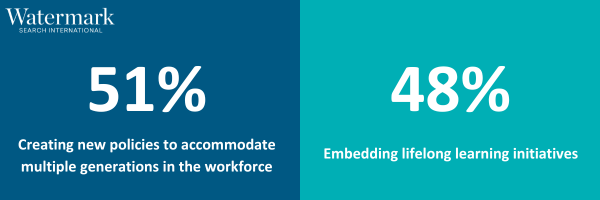Organisations are at a critical juncture in an era marked by shifting demographics and economic realities. The imperative to "refresh attraction and retention strategies" has taken centre stage, according to 68% of industry leaders. And longevity has emerged as an important trend for redefining the future workplace.
Watermark Search International’s 2023 Annual Interim Executive Survey (DOWNLOAD NOW) found many factors spur this workforce transformation. Watermark’s Managing Partner, David Evans, says, “The world is facing several changes simultaneously ‒ including a tight labour market, job churn from technological advancement and a declining population. Meanwhile, people in many countries worldwide are living ‒ and working ‒ longer. The World Health Organisation estimates that between 2015 and 2050, the proportion of the world’s population over 60 will nearly double.” In this new landscape, it is increasingly evident that longevity must be a cornerstone of a holistic recruitment strategy.
Dr Ben Hamer, Chief Futurist CreativeCubes.Co, adds, “Boards are increasingly asking their executive teams about the future, ‘Where will growth come from? Will we have the people to get us there? And what will need to change radically?' Building foresight capability and the muscle for future thinking is becoming one of the most important skills for the future, especially for those who play a lead role in shaping it.”
Embracing a multi-generational workforce
Organisations at the forefront of shaping the future of work will address the longevity challenge head-on. Our survey highlights two prominent strategies leaders say will help organisations adapt to their workforces’ needs and aspirations:
Creating new policies to accommodate multiple generations in the workforce (51%)
Embedding lifelong learning initiatives (48%).

A career portfolio approach
People are living longer, and the population is ageing. According to leading researchers, the average 10-year-old living in a country with one of the longest average life spans can expect to live to at least 100.
In just 11 years, millennials, who already represent the largest generation in the labour force, will start to turn 50. With retirement at 67 becoming less common, more people are planning diverse career portfolios, including Interim Executive roles, contracting, part-time work, flexible working, volunteering, advisory positions, and consulting gigs.
This trend creates opportunities for organisations to tap into a wealth of experience and expertise across various work arrangements.
Move away from reactive hiring practices
Another notable observation from our survey is a move away from reactively – rather than proactively – hiring people who are mature, neurodivergent or people with disabilities. Organisations can benefit from a more dedicated stance to diversity and designing attraction strategies targeting previously overlooked demographic brackets such as mature workers from diverse talent pools.
Top 3 most popular ways to build a longevity plan:
Building a solid professional network and maintaining positive relationships with former colleagues (69%).
Demonstrating a results-driven approach and adding value to each assignment (61%).
Continuing to develop new skills and keep current with industry trends and innovations (49%).

In an article for Esquire envisioning the workplace of 2040, journalist Michael Clinton writes, “In the 2040 workplace, there has been a massive movement to retain, retrain, and redeploy employee talent over 60. It’s not unusual for 70-year-olds to lead intergenerational initiatives, especially as most companies refocus on the needs of aging consumers and find themselves in talent wars for seasoned, experienced employees who understand the shifting landscape. A hot new executive search firm aligned with the new management breed has led the charge to break down the old-fashioned idea that people over 60 are not employable.”
The career mosaic replaces the ladder
Elatia Abate, founder of The Future of Now and a Forbes Leading Female Futurist, appears to agree with Clinton and claims the Career Ladder is a thing of the past.
She advocates the future of work as a Career Mosaic, an approach she says, “wouldn’t require someone to be a full-time employee, but rather working on multiple projects for multiple companies, participating in healthcare pools for their insurance needs. The anticipated growth of remote work options will add to the flexibility for older workers, as they avoid the physical toll of commuting, leaning into their mental acuity and knowledge to continue to contribute”.
Returnships and sabbaticals
Encouraging employees to take sabbaticals can improve retention and offer personal growth and skill development opportunities. Returnship programs can help revitalise organisations by bringing individuals back into the workforce, whether they are parents returning to work or retirees looking to resume their careers on a part-time or contractual basis.
Interim and contract workers bring maturity, mentoring, and diverse experiences to the workplace. This flexible approach to staffing can uplift capabilities and provide fresh perspectives.
A longevity formula for success
Watermark Search has developed a formula to help organisations and individuals create a longevity plan. This plan is based on extensive research and lived experiences. Here are our key recommendations:
Creative talent management – Consider your talent acquisition, retention, and utilisation differently. Understand how to explore and unleash the potential of a multi-generational workforce.
Cultivate a culture of respect for all employees – Create meaningful work and skill development opportunities that connect and engage employees of all ages.
Age and stage-inclusive policies – Ensure recruitment, assessment, retention, compensation, lifelong learning, health, wellness, and retirement policies are age- and stage-inclusive across your organisation.
Returnship programs – Attract and retain talent from various life stages. Flexible work arrangements can help entice talented and valuable people back to the workforce.
Leverage interim and contract workers – Implementing this as part of a successful recruitment strategy enables workers to benefit from their maturity, experience, and mentoring capabilities.

To sustain longevity, you must evolve
Career longevity is no longer a "nice to have" but a business imperative. Organisations already embracing a multi-generational workforce are reaping the rewards, including enhanced retention rates and the preservation of institutional knowledge. As with other diversity considerations, understanding the needs of older workers can lead to better strategies and increased profitability.
The data speaks for itself: economic activity driven by people aged 50 and above significantly contributes to global GDP. As the workforce ages, organisations that adapt to this demographic shift will thrive.
Organisations must actively plan for a multi-generational workforce, tap into diverse talent pools, and create an inclusive and respectful workplace culture to sustain longevity. The future of work is multi-faceted, and those who adapt will succeed in the longevity era.
To learn more about longevity in the workforce and to read about all things Interim Executive, please download our 2023 Annual Interim Executive Survey now.
